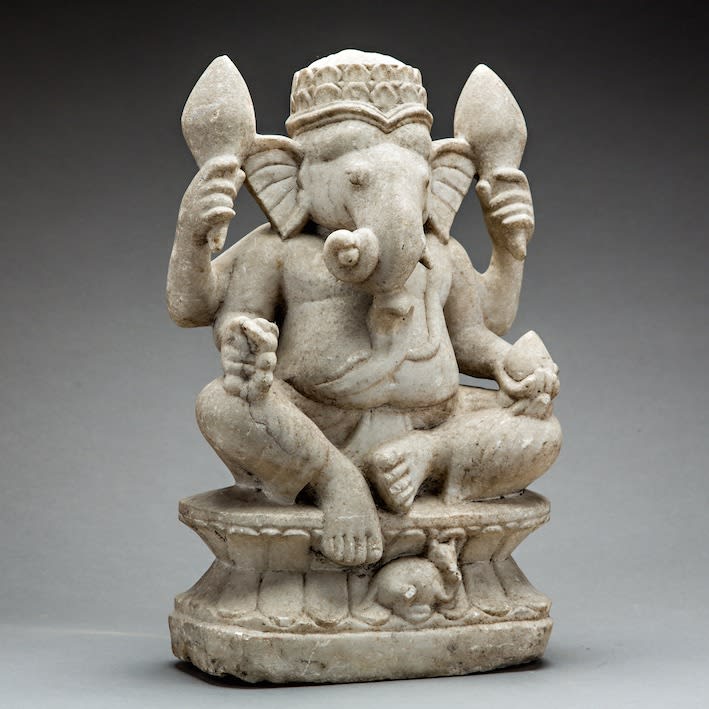Figure of Ganesh, Tenth to Thirteenth Century AD
Marble
40.6 x 24.1 cm
16 x 9 1/2 in
16 x 9 1/2 in
OF.269B
Further images
Ganesh is one of the most widely revered deities in the Hindu pantheon. First emerging as a distinct deity in India during the Gupta Period, his image began to proliferate...
Ganesh is one of the most widely revered deities in the Hindu pantheon. First emerging as a distinct deity in India during the Gupta Period, his image began to proliferate from the sixth century AD. There are several traditions regarding his parentage and the events that caused him to acquire the head of an elephant. One of the most widely accepted theories is that he was the son of Shiva and Parvati and was born with fully human features. On one occasion, angered by Ganesh’s closeness to Parvati, Shiva beheaded him in a fit of rage. He then replaced his original head with that of an elephant. Ganesh is venerated as a ‘remover of obstacles’ and a bestower of wealth, wisdom and success.
This exceptional marble sculpture represents the god sitting in the posture of grace (lalitasana), his right foot extending over the double lotus pedestal. A superbly carved rat or mouse sits on the base just to the right of the foot. Ganesh is frequently portrayed riding on a rat or attended by a mouse. The tradition began in India in the seventh century and according to some scholars reinforces his role as a ‘remover of obstacles.’ Rodents were associated with destruction, particularly damage to crops. Ganesh tames these instincts and ensures the success of man’s endeavours. He is frequently invoked at the start of any religious or secular undertaking, such as the beginning of a journey or the construction of a house.
Serpents were another common feature in Ganesh iconography. In this example a snake is wrapped diagonally around the torso, with his head rearing up just beneath the elephant’s trunk. Ganesh has four arms, the standard number in this period, one of which holds rosary beads, thought to represent the eternal quest for wisdom. The tight-fitting headdress is very detailed, with a wide band of leaf-shaped motifs, terminating in a ribbed top and a circular fastening. The wide ‘wing-shaped’ ears represent the deity’s openness to petitions from his followers and the rotund belly is another common attribute. It is thought that there are more shrines in India dedicated to Ganesh than any other deity. Amongst the many representations of Ganesh available on the market, this sculpture stands out for its early date and the exquisite quality of the carving. (AM)
This exceptional marble sculpture represents the god sitting in the posture of grace (lalitasana), his right foot extending over the double lotus pedestal. A superbly carved rat or mouse sits on the base just to the right of the foot. Ganesh is frequently portrayed riding on a rat or attended by a mouse. The tradition began in India in the seventh century and according to some scholars reinforces his role as a ‘remover of obstacles.’ Rodents were associated with destruction, particularly damage to crops. Ganesh tames these instincts and ensures the success of man’s endeavours. He is frequently invoked at the start of any religious or secular undertaking, such as the beginning of a journey or the construction of a house.
Serpents were another common feature in Ganesh iconography. In this example a snake is wrapped diagonally around the torso, with his head rearing up just beneath the elephant’s trunk. Ganesh has four arms, the standard number in this period, one of which holds rosary beads, thought to represent the eternal quest for wisdom. The tight-fitting headdress is very detailed, with a wide band of leaf-shaped motifs, terminating in a ribbed top and a circular fastening. The wide ‘wing-shaped’ ears represent the deity’s openness to petitions from his followers and the rotund belly is another common attribute. It is thought that there are more shrines in India dedicated to Ganesh than any other deity. Amongst the many representations of Ganesh available on the market, this sculpture stands out for its early date and the exquisite quality of the carving. (AM)





